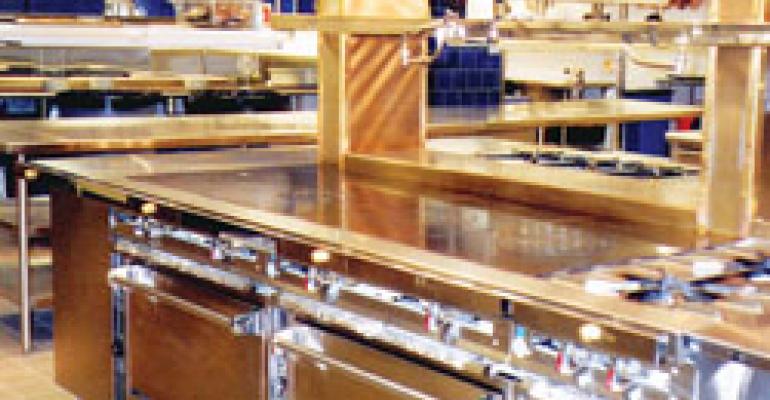Backed by a showplace kitchen as suited to braising beef short ribs in the oven as it is to infusing artichoke consommé in a vacuum pouch, Tru is striding into its second decade as a fine-dining landmark grounded in tradition, yet open to culinary experimentation.
The award-winning restaurant opened in Chicago in May 1999, the fruit of a partnership between accomplished chefs Rick Tramonto and Gale Gand and founder and chairman Richard Melman of Lettuce Entertain You Enterprises, the Chicago-based multiconcept restaurant operator. With Melman’s backing, Tramonto and Gand realized a vision of progressive French dining featuring tasting menus of unusual ingredients and flavor combinations, served with a more down-to-earth attitude than the typical haute-cuisine spot. The cutting-edge cuisine continues to this day, reflected in such dishes as Salt-Crusted Cervena Venison with Cocoa, Olive and Blood Orange, and Chocolate Bar with Wattleseed Ice Cream, Burnt Caramel Mousse and Malted Caramel.
One of the keys to Tru’s lasting success is a large, well-endowed kitchen with an island-style cooking suite as its centerpiece. The partners designed it from the ground up in the bar and dining room area of Avanzare, a former LEYE Italian restaurant that was gutted for the new concept.
“I had never seen anything like it—the island, the granite counter tops, the copper pots hanging everywhere,” said Tim Graham, the young culinarian who in the span of five years advanced from a garde manger position to accept the executive chef reins from Tramonto, who remains chef-partner.
With culinary school training plus a background in biochemistry, genetics and food science, Graham moves fluidly between traditional cooking methods like sautéing, roasting and poaching and modern approaches that rely on the vacuum sealer, thermal circulator and steam distillation unit. Like a scientist, he works with precise laser thermometers and digital scales that measure in the tenths of grams.
“It’s up to me to be rigorous and weigh everything that I use,” Graham said.
But for him, the bottom line is flavor—however it is achieved—not technique.
Although he could easily make Tru’s Olive Oil Poached Arctic Char in a thermal circulator, he prefers to poach it in a pot of oil placed over the pilot light of the island, which holds the correct temperature. And he prefers the results of braising beef short ribs for hours in the oven, as cooks have done for ages, over cooking them sous vide.
Where he sees fit, he uses the vacuum sealer and thermal circulator to infuse flavor and aroma into soups and sauces. He calls the technique “my poor man’s Gastrovac,” referring to an expensive flavoring apparatus used in some forward-looking kitchens. For example, he cooks French onion soup with Gruyère cheese under vacuum. After the cheese is strained out, the soup has profound Gruyère flavor, but not the “goopiness” of cheese-topped French onion soup, he noted. In similar fashion, he enhances artichoke consommé by cooking it with additional artichoke hearts and leaves under vacuum. He also makes grilled-jalapeño oil in much the same way.
Another high-tech tool is a steam distillation unit designed for perfume making, which he uses to extract essential oils from orange zest, lemon grass and flower petals.
“I found out why perfumes are so expensive,” Graham said. “It took a pound of rose petals to yield a very small amount of essential oil.”
Painting a little essential oil on a warm plate before it leaves the kitchen activates the aromas “and just smells insane to the guest,” he said.
A background in food science is an undoubted asset in this kind of cooking, Graham said.
“More than anything, it has helped me be comfortable and understand what is happening,” he said.
Still, Graham stresses that his forays into experimental cookery are selective and not publicized to guests. He said he respects, but does not wish to emulate, a place like Alinea, the Chicago restaurant in the vanguard of molecular gastronomy, creating intriguing flavors and textures in food by manipulating ingredients with scientific techniques.
“I like that they have developed modern tools, and I put them in my toolbox right next to the old tools,” Graham said. “But we will always sauté. We will always use the flattop.”

